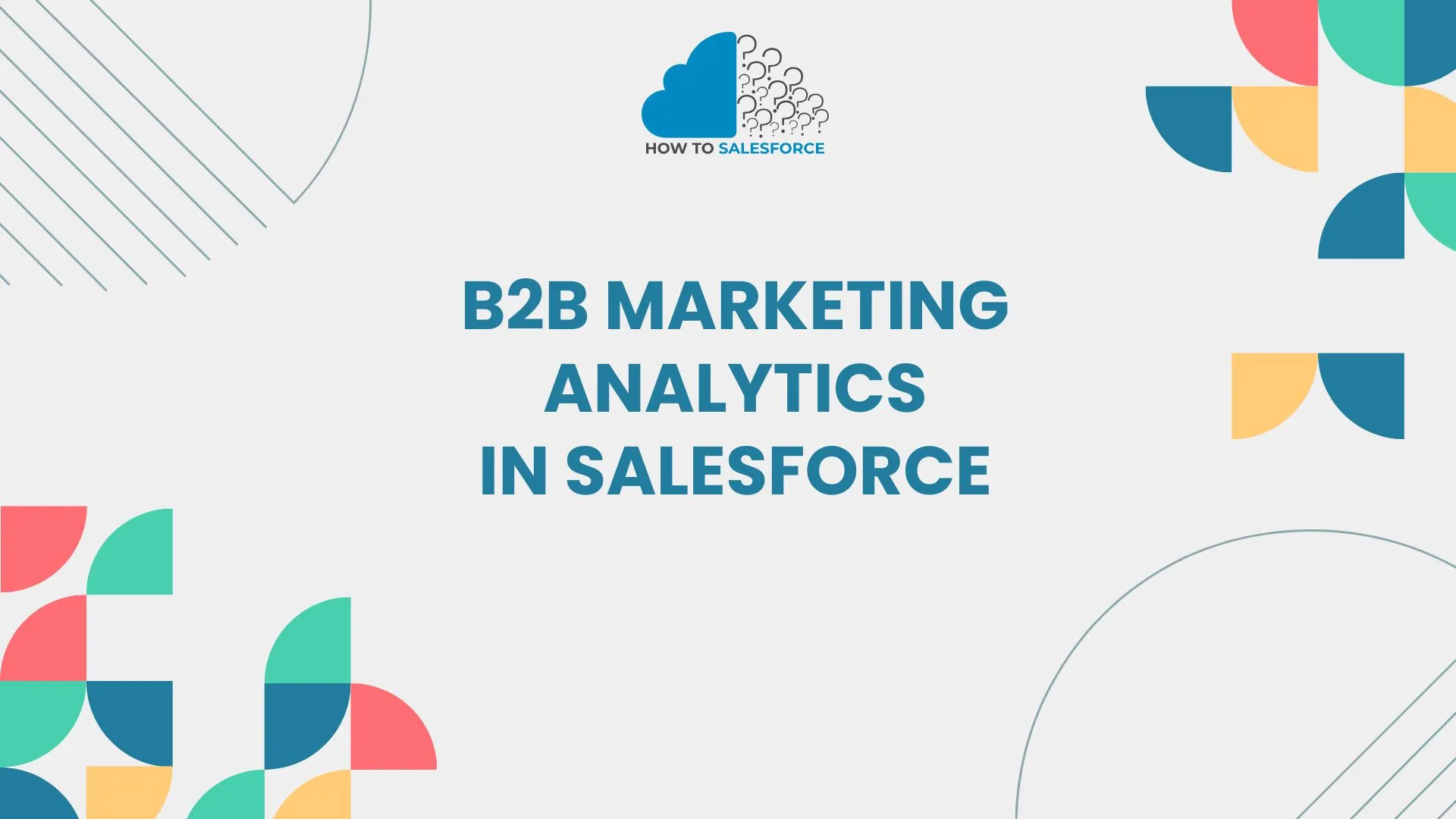Companies use data to make better decisions in the current competitive environment. B2B marketing analytics are essential for developing successful strategies, understanding consumer behavior, and optimizing campaigns. This blog post will discuss how to use analytics from B2B marketing to help your business succeed.
Please read my other blog: Delegated Administrator In Salesforce
What is B2B Marketing Analytics
Firstly, data collection, analysis, and interpretation from marketing activities is called business-to-business (B2B) marketing analytics. Businesses can use it to monitor performance, gauge the effectiveness of campaigns, and pinpoint areas in need of development. Businesses can optimize returns on investment, make well-informed decisions, and improve strategies by utilizing data-driven insights.
Why is B2B Marketing Analytics Important
B2B marketing analytics is crucial because it provides insightful information about market trends, customer behavior, and the efficacy of campaigns. For B2B marketing, analytics is essential for the following main reasons:
- Improves Targeting: Analytics assist in determining the appropriate audience, guaranteeing that marketing initiatives are seen by prospective clients.
- Improves Campaign Performance: Marketers can monitor which tactics are effective and adjust them for greater outcomes.
- Increases ROI: Data-driven choices result in more effective marketing expenditures, which cut down on waste and boost income
Key Metrics in B2B Marketing Analytics
Secondly, businesses must concentrate on particular metrics that show performance if they want to fully comprehend B2B marketing analytics. The following are some of the most important metrics to monitor:
Lead Generation: B2B Marketing Analytics
One essential metric for business-to-business (B2B) marketers is lead generation. It calculates how many prospective clients were attracted by marketing initiatives. Businesses can assess the success of their lead-generation strategies by keeping track of this.
- Key Metric: The quantity of leads produced for each campaign.
- Why It Matters: B2B sales survive on leads.
Conversion Rate
The number of leads that became paying customers is indicated by the conversion rate. Marketers can use this metric to assess whether their tactics are drawing in the correct customers and guiding them through the sales funnel.
- Key Metric: The proportion of leads that become clients.
- Why It Matters: A higher conversion rate is a sign of successful sales and marketing coordination.
Customer Acquisition Cost (CAC)
Acquisition of Customers Cost quantifies the amount of money a business spends on acquiring new clients. Businesses can evaluate the cost-effectiveness of their marketing campaigns by looking at CAC.
- Key Metric: The ratio of total marketing expenditure to new client acquisition.
- Why It Matters: Profitability rises when CAC is reduced.
Customer Lifetime Value (CLV)
Customer Lifetime Value calculates how much money a company can make from a client throughout their association with the business. It is an important indicator of long-term profitability.
- Key Metric: Average revenue per customer times the length of time they have been a customer.
- Why It Matters: Strong customer loyalty and retention are indicated by a higher CLV.
Types of B2B Marketing Analytics
Additionally, there are several types of B2B marketing analytics, each offering a unique viewpoint on data. The primary analytics types utilized in B2B marketing are as follows:
Descriptive Analytics
The goal of descriptive analytics is to summarize past data to comprehend the events that transpired during a marketing campaign. It assists marketers in recognizing patterns, trends, and the general effectiveness of their tactics.
- Example: Examining previous email campaigns to ascertain click-through and open rates.
Predictive Analytics
Predictive analytics forecasts future events based on historical data. It assists marketers in forecasting consumer behavior, sales trends, and possible obstacles by spotting patterns.
- Example: Forecasting the performance of a future campaign using historical campaign data.
Prescriptive Analytics
Moreover, beyond forecasting, prescriptive analytics provides insights that can be put into practice. It offers suggestions for what steps companies should take to maximize their upcoming marketing campaigns.
- Example: Using data on customer behavior to recommend the optimal email sending time.
Tools for B2B Marketing Analytics
Businesses can use a variety of tools to implement B2B marketing analytics. By gathering, processing, and analyzing data, these tools provide marketers with insightful information. Here are a few of the most widely used tools:
Google Analytics
Google Analytics is one of the most popular tools for monitoring the performance of websites. For B2B marketers, it is a crucial tool because it offers information on traffic, user behavior, and conversions.
- Key Feature: Monitors traffic sources, user engagement, and website visitors.
- Why Use It: It’s simple to integrate with other marketing tools and is free.
HubSpot Marketing Analytics
HubSpot provides a thorough analytics platform that monitors a variety of metrics, including the effectiveness of email marketing and lead generation. It is made especially for business-to-business (B2B) marketers.
- Key Feature: Offers an in-depth understanding of the entire sales funnel.
- WHY USE IT: It integrates with CRM systems without any problems.
Salesforce Marketing Cloud
Furthermore, a potent analytics tool for monitoring multi-channel marketing campaigns is Salesforce Marketing Cloud. Marketers can quickly optimize their strategies thanks to the real-time data it provides.
- Key Feature: monitoring marketing campaigns in real-time on multiple platforms.
- WHY USE IT: Aids in streamlining the entire customer journey, from lead to conversion.
Tableau
A data visualization tool called Tableau assists marketers in producing eye-catching dashboards and reports. It makes deciphering complex data easier.
- Key Feature: sophisticated data visualization for a more thorough examination.
- Why Use It: Perfect for marketers who wish to display data in an understandable, eye-catching manner.
Challenges in B2B Marketing Analytics
Although B2B marketing analytics offer insightful information, there are certain drawbacks. For data analysis to be effective, it is essential to comprehend these difficulties.
Data Silos
When departments within an organization don’t share their data, it’s called a data silo. Incomplete analysis and poor decision-making may result from this.
- Solution: Put in place a sales and marketing system that is integrated and unifies all data into a single platform.
Data Overload
Marketers may become overwhelmed by too much data and find it difficult to concentrate on the important things. The most crucial metrics for their company must be given top priority by marketers.
- Solution: Pay attention to key performance indicators (KPIs) that support your company’s objectives.
Data Accuracy
For decisions to be made effectively, accurate data is essential. However, inaccurate or out-of-date data can occasionally result in misguided strategies.
- Solution: To guarantee accuracy, clean and update your data regularly.
Best Practices for B2B Marketing Analytics
Businesses should adhere to these best practices to maximize the benefits of B2B marketing analytics:
Define Clear Goals
Marketers should establish their objectives before beginning data analysis. Well-defined goals aid in directing the analytics procedure and guarantee that companies concentrate on the most pertinent metrics.
- Example: Track lead acquisition metrics if you want to increase lead generation.
Regularly Monitor Performance
Analytics for B2B marketing is a continuous process. Marketers should keep a close eye on performance to spot trends and make the required corrections.
- As an illustration: Evaluate campaign performance every month to make sure you continue to meet your objectives.
Use A/B Testing
Marketers can test various iterations of a campaign using A/B testing to determine which one works best. This technique aids in maximizing the efficacy of strategies.
- Example: Try a variety of email subject lines to determine which ones get the most opens.
Integrate Data Across Platforms
Furthermore, businesses should combine data from all marketing channels to get a comprehensive view of marketing performance. This guarantees that marketers can conduct a comprehensive analysis of campaigns.
- Example: To gauge overall efficacy, aggregate data from paid advertisements, social media, and email campaigns.
How to Implement B2B Marketing Analytics
Careful preparation and execution are necessary when implementing B2B marketing analytics. The steps to begin are as follows:
Step 1: Set Clear Objectives
Start by establishing clear goals for your analytics on B2B marketing. What do you want to accomplish? Having specific goals is crucial, whether the goal is to increase conversions or improve lead generation.
Step 2: Choose the Right Tools
Choose analytics tools that support your company’s objectives. For instance, Google Analytics might be your greatest choice if you need to monitor the performance of your website.
Step 3: Collect Data
After deciding on your tools and establishing your goals, begin gathering information from your marketing campaigns. Make sure you are monitoring the most pertinent metrics.
Step 4: Analyze Data
Examine the gathered data to find trends, patterns, and areas that need improvement. Make changes to your marketing tactics based on this information.
Step 5: Optimize Campaigns
Lastly, use the knowledge gathered from your data analysis to improve your campaigns. To guarantee ongoing success, evaluate and modify your tactics regularly.
Conclusion
In conclusion, companies trying to maximize their marketing strategies must have B2B marketing analytics. Businesses can boost ROI, enhance campaign performance, and make well-informed decisions by utilizing data. Employing B2B marketing analytics will help you stay ahead of the competition, regardless of whether you’re monitoring lead generation, conversion rates, or customer acquisition expenses. To get the most out of your B2B marketing initiatives, embrace data-driven decision-making now.


